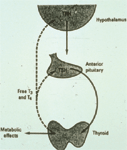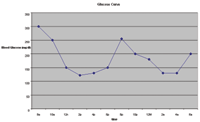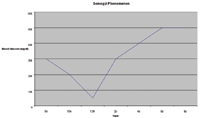Endocrine testing of cats (Proceedings)
Feline Hyperthyroidism
I. Feline Hyperthyroidism
A. basal T4 concentration
1 useful in most cases
2 if normal in a suspected individual, repeat in 1-2 weeks since hormone levels will fluctuate
3 can be affected by nonthyroidal illness – artificially lowers T4
B. free T4 concentration
1 measure by equilibrium dialysis
2 removed interference by thyroid hormone binding hormone
3 12% of normal cats with nonthyroidal illness had elevated fT4
4 cannot use as a as a sole diagnostic test
C. dynamic endocrine testing – TSH stimulation test
1. Protocols being worked out
2. TSH expensive and difficult to obtain
D. T3 suppression test – T3 suppression test
1. Most definitive way to diagnose hyperthyroidism
2. Use infrequently

II. Diabetes Mellitus
Diagnosis
A. Minimum workup: CBC, Chemistry, UA, Urine culture
B. CBC - mature neutrophilia +/- left shift if concurrent infection/inflammation (pancreatitis)
C. Chemistry
1. hyperglycemia
2. hyperlipidemia
3. hypercholesterolemia
4. Elevated liver enzymes
5. ketosis
D. Urinalysis
1. USG – isosthenuria (osmotic diuresis)
2. Glucosuria - cat: renal glucose threshold ~ 250 mg/dl
3. Proteinuria
4. sediment: WBC, bacteria if urinary tract infection
5. ketones if ketotic
E. Specific Diagnosis
1. to diagnose diabetes mellitus, want to document persistent hyperglycemia;
a. cats, can become very stressed and hyperglycemic
b. blood glucose can get very high in stressed animals and can be >300 mg/dl
c. stressed animals can spill glucose into their urine
d. repeat later when animal calmer
e. serial blood glucose measurements or THE GLUCOSE CURVE
2. fructosamine
a. fructose + albumin
b. irreversible binding
c. half life of albumin
d. reflect glycemic control over the previous 2-3 weeks
e. the higher the fructosamine, the poorer the control
f. altered by severe hypoalbuminemia
3. Ketones
a. the primary ketones found in dogs and cats are: acetone, acetoacetic acid, β-hydroxybutyric acid.
b. formed in unregulated diabetics from an insulin deficiency and diabetogenic hormone (primarily glucagon) excess.
c. eliminated in urine
d. if found in urine with glucosuria, you can diagnose diabetes mellitus
F. The glucose curve
1. in-dwelling, sampling catheters
2. blood collection every 2 hours
3. plot on curve with feeding time and amount of insulin given
4. helps determine correct type and dose of insulin

G. Things a glucose curve can tell you that you can't find out any other way:
1. Somogyi phenomenon
a. Insulin overdosage (Somogyi phenomenon)
i. Blood glucose < 60 mg/dl
ii. Release of counter-regulatory hormones
iii. Causes compensatory hyperglycemia
iv. Can persist for days

H. Interstitial glucose monitoring
III. Hyperadrenocorticism (Cushing's Disease) testing in cats
Dynamic Endocrine Testing
A. Low Dose Dexamethasone Suppression Test – use 0.1 mg/kg of dexamethasone (instead of 0.01 mg/kg of dex for a dog); use the same criteria for diagnosing hyperadrenocorticism
B. ACTH-stimulation test
i. 5 ug/kg synthetic ACTH IV
ii. Cortisol levels at 60 and 90 minutes
iii. Cortisol above 16 ug/dl (slightly lower than dogs) consistent with hyperadrenocorticism
C. Adrenal ultrasonography
Inhaled albuterol offers more accessible treatment option for elevated potassium levels in cats
April 2nd 2025A recent study explored the effect of inhaled albuterol sulfate in reducing blood potassium levels in felines, which offers a potential treatment option for urinary obstruction-related hyperkalemia
Read More